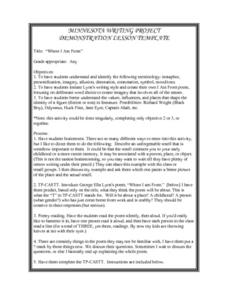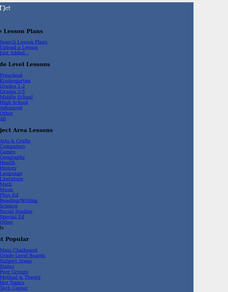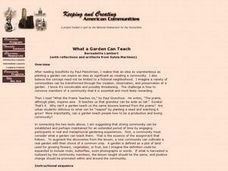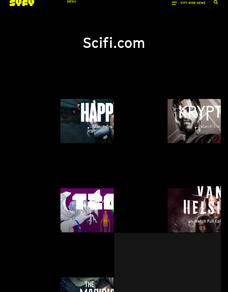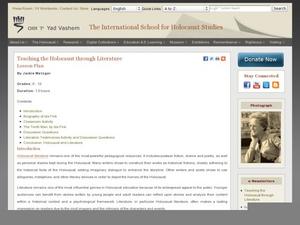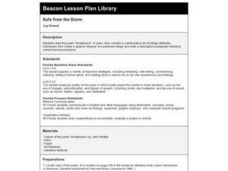Curated OER
Where I Am From
Students study selected poetry to gain an understanding of influences on values and personal identity. They explore language terms such as personification, imagery metaphors and allusion. After reading a poem and discussing it,...
Curated OER
The Tell Tale Heart
Eighth graders explore storytelling by listening to a reading of a classic poem. In this language arts lesson, 8th graders listen to an audio recording of Edgar Allen Poe's The Tell-Tale Heart. Students examine the life of...
Curated OER
Flowers, Flowers, Flowers...A Visit with Georgia O'Keeffe
Students analyze, discuss, and research Georgia O'Keeffe and her flower paintings. They select a flower to paint and create a watercolor painting in the style of Georgia O'Keeffe. Students compose a poem describing their painting.
Curated OER
Figurative Language Scavenger Hunt
Eighth graders analyze and interpret figurative language. They listen to some examples of poetry which use figurative language. Then, they divide into groups and attempt to find more examples. Finally, 8th graders write what the poet is...
Curated OER
Octavio Paz
Tenth graders read and analyze the poem, "The Street," by Hispanic author, Octavio Paz. They research the life of Octavio Paz and identify his literary contributions. They complete an online scavenger hunt and create an author map of...
Curated OER
Stain My Days Blue
Students read several poems related to the life and culture of the Appalachia region. They are introduced to the poetic forms of simile, alliteration and onomatopoeia and respond to the poems through journal entries and poetry of their own.
Curated OER
Reflecting/Writing after a field trip or other experience
Students reflect on field trips in writing. In this journal writing lesson, students write about a recent experience by using 4 of their senses to tell what they remember. They turn these into poetry.
Curated OER
Imagery
Students read the poem The Worker by Richard W. Thomas as an example of the effective use of imagery. Then they complete a 5-senses chart describing some part of nature, e.g. sea, clouds, etc. Then they write their own poem using the...
Curated OER
Alliterations Allowed
Fourth graders recognize and create alliterative language in both literary and commercial use. In this language arts lesson, 4th graders analyze pieces of poetry and focus on the use of imagery, personification, and figures of speech.
Curated OER
Description and Modifying: What's On Your Plate?
Students create a food product and an advertisement promoting it. In this description and advertising lesson, students read children's book for inspiration and discover advertising techniques. Students complete their ads and...
Curated OER
What a Garden Can Teach
Learners read about land and gardening and create found poems from the text. They use the poems to design interpretation quilts of communal text.
Curated OER
English Year 6: Furniture Game Sequences
Sixth graders create, illustrate and present a collaborative poem sequence using a variety of software.
Curated OER
The Witch of Goingsnake
Learners identify figurative language in a proverb and write an interpretation of the proverb prior to reading The Witch of Goingsnake. In this The Witch of Goingsnake lesson plan, students read a native American proverb and determine...
Curated OER
Literature Collaborative Learning Project
Young scholars, in groups, from Israel study literature in English. They practice communicating in the language and to write poems. They create a website in English describing aspects of their country.
Curated OER
Figurative Language 2
Students read nursery rhymes and advertisements to identify examples of figurative language. As a class, students discuss the use of figurative language and its effectiveness in advertising, children's books, rhymes, poetry, etc. ...
Curated OER
Journeys to Self Discovery
Students explore both physical and mental journies that result in a change or self-discovery. They write poems that symbolize a personal journey that forever changed them. They understand the importance of a central image or metaphor in...
Curated OER
Figurative and literal language through the study of Shakespeare
Sixth graders explore figurative and literal language. They study literary devices through short pieces of Shakespeare's work. Then investigate Shakespeare's works and life.
Curated OER
Analyzing the Use of Irony in a Short Story
Ninth graders examine how literature connects to real-life and see how irony aids in the development of theme. They read Shirley Jackson's The Lottery, and discuss elements of foreshadowing and situational irony. Then learners will write...
Curated OER
Teaching the Holocaust through Literature
Centered on the short story "The Tenth Man" by Polish Holocaust survivor Ida Fink, here is a solid one-day resource to support study of World War II or Nazi history, short stories, or to complement any ELA unit on The Diary of Anne Frank...
Shmoop
ELA.CCSS.ELA-Literacy.RL.9-10.10
How do you assess what your pupils have learned over the course of the year? Find out how competent they are at reading and analyzing age-level literature with the ideas presented here. Included in this resource are two suggested...
Gwinnett County Public Schools
Analysis of the Tuck Everlasting and The Birchbark House Text Exemplars
Looking to introduce some text-based questions into your ELA lessons? Practice the kinds of skills the Common Core demands with the seven text-based questions and the essay prompt provided here. Designed to be a three-day instructional...
Curated OER
Poetic Devices
In this figurative language worksheet, pupils read and study examples of simile and metaphor. There are 20 questions to be used with Smartboard and 10 questions in which students identify similes or metaphors.
Curated OER
Sonnet
Students research and read other sonnets. They discuss the the history and significance of meter and rhythm in poetry. Students demonstrate the ability to write a poem using the format of a sonnet.
Curated OER
Safe from the Storm
Fourth graders read the poem "Snowbound" after brainstorming what a place of refuge is and why it's needed. They, in pairs, meet and write a list of ten attributes that describe a refuge. They write a paragraph describing the look, feel,...


